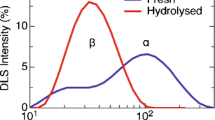Summary
Round granules about 200 Å in diameter have been observed in the sinusoids bordering cells of human liver and possibly also in the hepatocytes. These granules clustered together to form clumps 0.3 μ in diameter, are enclosed in a fine cytoplasmic membrane, and are very similar in appearance to the so-called “monoparticulate” glycogen present in cells of extrahepatic tissues. These granules are of glycogenic nature as shown by their sensitivity to a prolonged diastase treatment.
Similar content being viewed by others
References
Babudieri, B., E. Fiaschi, R. Naccarato, and A. Scuro: Presence of virus-like bodies in liver cells of patients with infectious hepatitis. J. clin. Path. 19, 577–582 (1966).
Drochmans, P.: Morphologie du glycogène. Etude au microscope electronique de colorations négatives de glycogène particulaire. J. Ultrastruct. Res. 6, 141–163 (1962).
— La morphologie du glycogène. Bruxelles: Arscia S. A. 1965.
Author information
Authors and Affiliations
Additional information
Assistent of the Institute of Medical Pathology, University of Padova.
Rights and permissions
About this article
Cite this article
Babudieri, B., Fagiolo, U. & Tangucci, F. Monoparticulate glycogen in human liver. Histochemie 15, 184–186 (1968). https://doi.org/10.1007/BF00306367
Received:
Issue Date:
DOI: https://doi.org/10.1007/BF00306367




